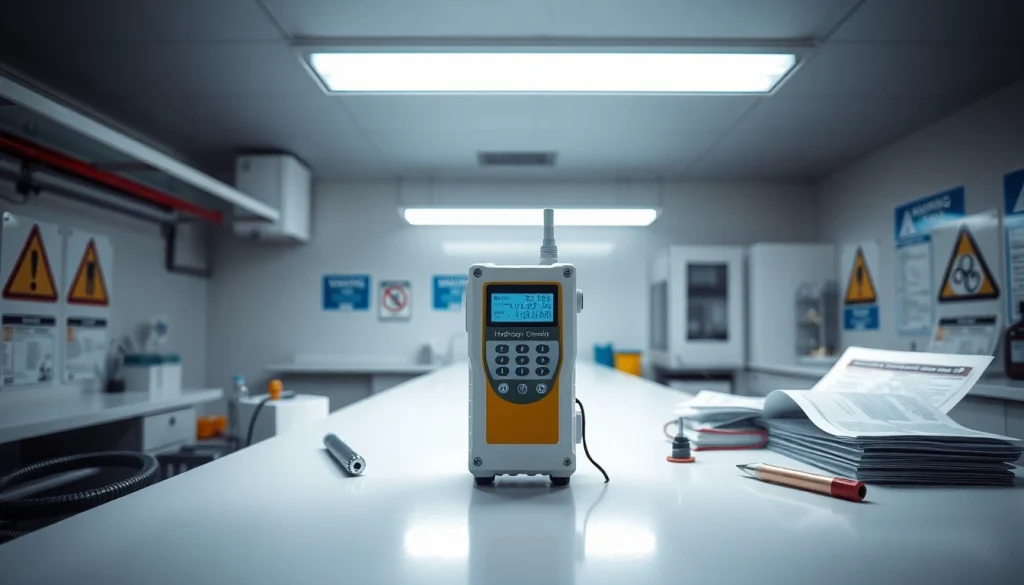Ensuring Safety with Hydrogen Cyanide Gas Detectors: Features, Applications, and Best Practices

Understanding Hydrogen Cyanide and Its Dangers
What is Hydrogen Cyanide?
Hydrogen cyanide (HCN) is a highly toxic, colorless gas with a distinct, bitter almond-like odor. This chemical compound is notably used in various industrial processes, including the synthesis of plastics, pesticides, and pharmaceuticals. It is also known to be released as a byproduct of combustion in certain materials, making it a potential hazard in industrial environments and situations like house fires. Understanding the properties of hydrogen cyanide is crucial for mitigating risks associated with its exposure.
Health Risks Associated with Hydrogen Cyanide
The health impacts of hydrogen cyanide exposure can be severe and potentially fatal. When inhaled, hydrogen cyanide can be absorbed rapidly into the bloodstream, leading to symptoms that range from mild headaches and dizziness to severe respiratory failure and death. The gas inhibits cellular respiration by blocking the body’s ability to utilize oxygen, which is why even a small concentration can be deadly. Occupational exposure limits are often set to prevent harmful effects in the workplace; these limits emphasize the importance of effective Hydrogen Cyanide gas detectors to monitor air quality and prevent exposure.
Regulatory Standards for Gas Detection
To safeguard workers and the environment from the risks posed by hydrogen cyanide, regulatory bodies impose strict guidelines on the acceptable levels of HCN in the air. Agencies like the Occupational Safety and Health Administration (OSHA) and the American Conference of Governmental and Industrial Hygienists (ACGIH) have established permissible exposure limits. Compliance with these standards is crucial for industries where hydrogen cyanide is present, making reliable gas detection and monitoring systems essential components for workplace safety and health management.
The Importance of Hydrogen Cyanide Gas Detectors
How Gas Detectors Function
Hydrogen cyanide gas detectors are sophisticated devices designed to identify the presence of HCN in the environment. These detectors typically incorporate sensor technology that responds to the specific chemical properties of hydrogen cyanide. There are various types of sensors, including electrochemical, catalytic, and photoionization detectors (PID), each with its unique mechanisms for detecting gas concentrations. The performance and reliability of a gas detector largely depend on its calibration, advanced technology, and specificity to various gases.
Choosing the Right Gas Detector for Your Needs
Selecting the appropriate hydrogen cyanide gas detector involves several factors. Key considerations include the intended application, the required sensitivity and response time, the power source, and environmental conditions such as temperature and humidity. For instance, portable gas detectors are ideal for routine inspections and emergency response, while fixed detectors are better suited for continuous monitoring in high-risk areas. Ultimately, the choice of gas detector should be aligned with industry requirements and specific workplace hazards.
Typical Applications for Hydrogen Cyanide Detection
Hydrogen cyanide gas detectors find applications across various industries, including chemical manufacturing, mining, and agribusiness. In the chemical sector, they are used to monitor exposure during the production of pesticides and synthetic fibers. In mining, HCN detection is critical in underground operations to ensure the safety of workers. In agriculture, where HCN can be released during the application of certain fertilizers, these detectors serve to protect workers and nearby communities from exposure.
Features to Look for in a Hydrogen Cyanide Gas Detector
Key Functionalities of Reliable Detectors
When selecting a hydrogen cyanide gas detector, there are several features that can enhance its effectiveness. First, sensitivity and specificity to hydrogen cyanide are paramount; detectors must accurately identify HCN while filtering out interference from other gases. Additionally, a fast response time is necessary to provide early warnings. The ability to store data, calibrate automatically, and integrate with alarms and other safety systems further enhances the reliability and usability of these detectors.
Technology Advancements in Gas Detection
The field of gas detection technology is continually evolving, with innovations aimed at improving safety and efficiency. Recent advancements include the development of wireless detectors that facilitate remote monitoring and data analysis. Also, the integration of machine learning algorithms allows for predictive analytics, enabling proactive measures against potential hazards. These technologies greatly enhance the overall effectiveness of hydrogen cyanide gas detectors, making them indispensable tools in safety management systems.
Comparative Analysis of Available Models
Not all hydrogen cyanide gas detectors are created equal; hence, performing a comparative analysis of available models is essential for organizations. Factors to consider include detection range, battery life, build quality, user interface, and cost. Leading manufacturers often provide performance metrics and user reviews to assist in this evaluation. It’s also beneficial to reference third-party testing certifications, which can provide assurance of the detector’s reliability in real-world scenarios.
Best Practices for Using Hydrogen Cyanide Gas Detectors
Installation and Setup Guidelines
The proper installation and setup of hydrogen cyanide gas detectors are critical for ensuring accurate readings and adequate responses to gas presence. Installations should comply with manufacturer recommendations and regulatory requirements. Detectors are typically placed in high-risk areas, such as near potential sources of hydrogen cyanide or in areas where gas accumulation may occur. Proper calibration, testing, and adherence to safety protocols are essential during this phase to establish reliable monitoring systems.
Regular Maintenance and Calibration Procedures
Regular maintenance and calibration of hydrogen cyanide gas detectors are vital for ensuring their continued accuracy and functionality. Maintenance schedules should be adhered to rigorously, including routine visual inspections, function tests, and recalibration. Many manufacturers recommend calibration every 6 to 12 months, depending on usage and environmental conditions. Keeping documentation of maintenance activities provides a useful reference for compliance audits and improving safety management protocols.
Ensuring Employee Training and Safety Protocols
An often-overlooked aspect of using hydrogen cyanide gas detectors is the training of personnel who operate them. Employees should be adequately trained on recognizing the gas detection system features, understanding alarm signals, and conducting proper usage protocols. Safety drills and emergency response plans should be conducted regularly to enhance preparedness. Ensuring that all employees understand the risks associated with hydrogen cyanide and the functioning of detection systems greatly contributes to a safer work environment.
Future Trends in Hydrogen Cyanide Detection Technology
Innovations in Sensor Technologies
As technology progresses, innovations in sensor technologies for hydrogen cyanide detection are expected to enhance safety and efficiency. Novel materials and designs, such as microfabricated sensors and nanomaterials, are showing promise for increased sensitivity and selectivity. Additionally, multi-gas sensors capable of detecting various toxic gases simultaneously are becoming more mainstream, allowing for a comprehensive approach to environmental monitoring.
Integration with Smart Monitoring Systems
The integration of hydrogen cyanide gas detectors with smart monitoring systems is paving the way for advancements in occupational safety. Leveraging IoT (Internet of Things) capabilities, these systems can provide real-time feedback and data analytics for better decision-making. Facility managers can monitor multiple detectors from a centralized dashboard, receive instant alerts, and analyze trends for predictive insights. This approach not only improves responsiveness but also enhances strategic planning for safety improvements.
Impact of Regulations on Detector Development
The evolution of regulations surrounding hydrogen cyanide detection is significantly impacting the development of new detector technologies. As safety standards become more stringent, manufacturers are compelled to innovate to meet compliance requirements. This creates an environment where continuous improvement in detection technologies occurs, fostering safer working conditions in industries handling hazardous chemicals. An understanding of these evolving regulations is crucial for companies as they choose their gas detection solutions.







